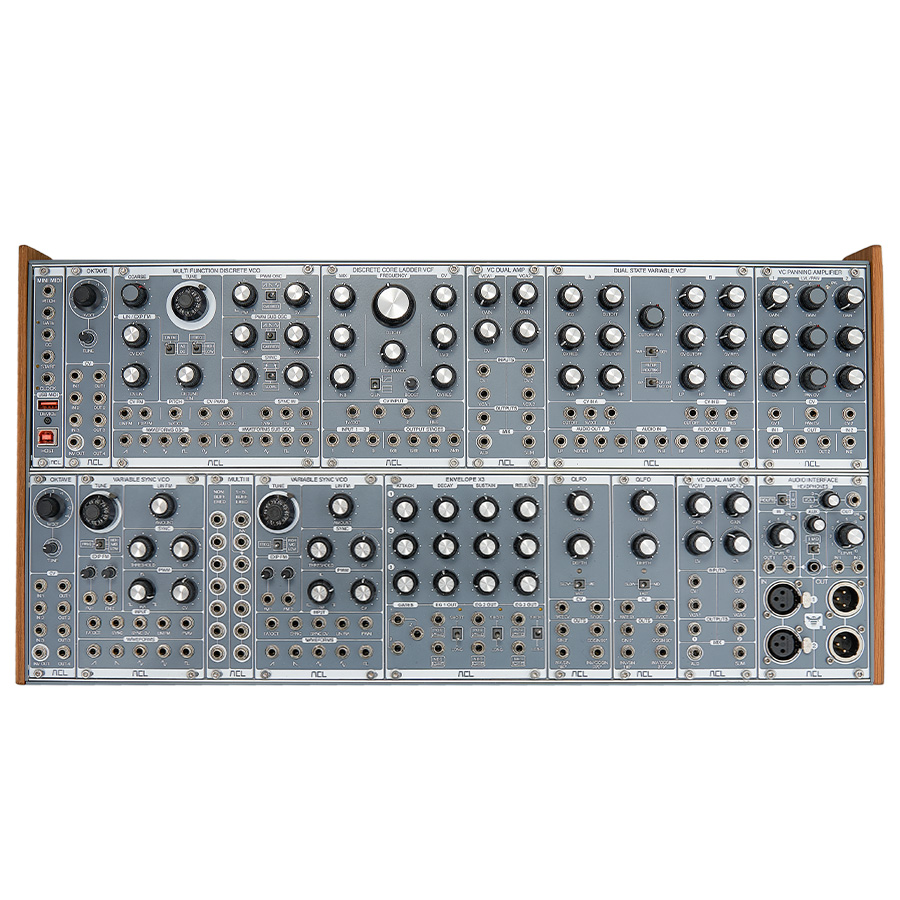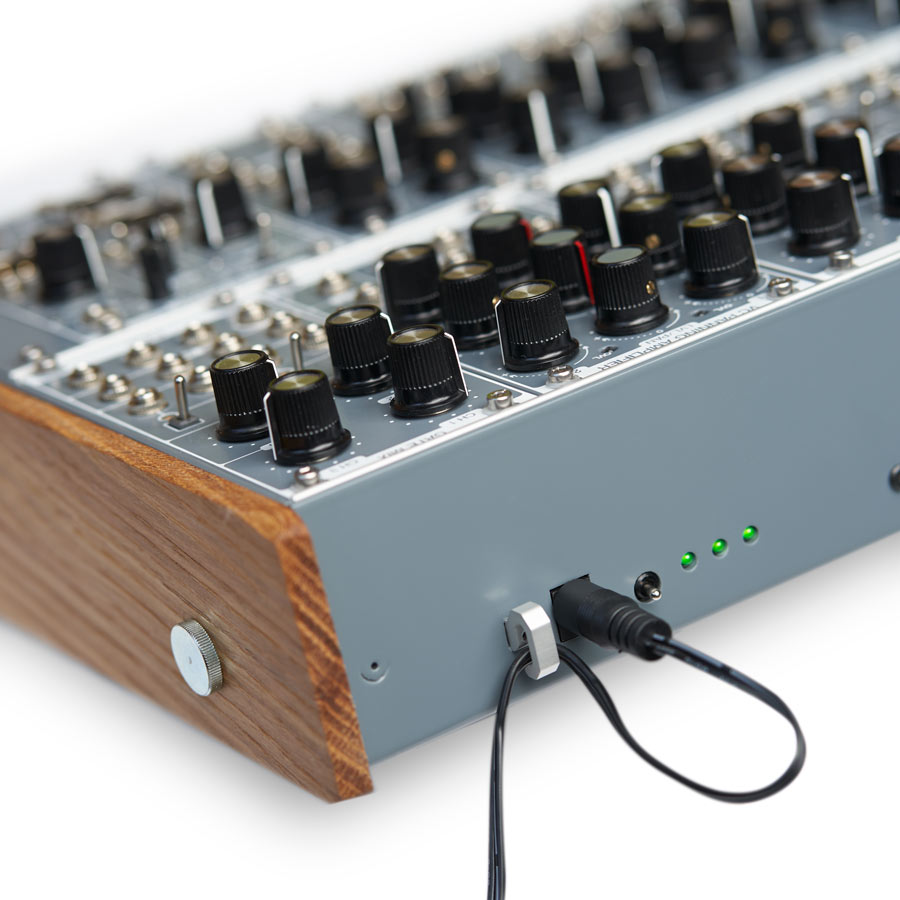What is System 3? A System 2 on steroids? The illegitimate lovechild of System 1 and System 2? A modulation lover’s paradise? Or is it all of those?
It won′t surprise you to learn that our designs are heavily influenced by whatever we were playing with at the time.
For example, System 1, our stereo-friendly system, was birthed during late night sessions with the M/S Matrix, VC Panning Amplifier, Dual State Variable VCF and Dual Delay prototypes.
System 2 came from toying with those budget analogue mono−synths flooding the market, and dreaming of one with premium components, a well−spaced layout, and a lifespan measured in decades, not months.
System 3? Well, System 3 came from playing about with System 1 and System 2 in conjunction with our new Mini MIDI module. Mini MIDI′s ability to convert MIDI CCs directly into modular friendly CC, with all the control that offered over modulation, set us down an addictively creative path, and we knew we had to share it.
System 3 very much has the mono−synth vibe of System 2, coupled with some of the stereo−tricks of System 1, but it′s really about modulation and experimentation.
On lead…
Sound generation comes courtesy of one Multifunction Discrete VCO and a pair of Variable Sync VCOs. So, three oscillators. But with up to 20 simultaneous waveforms (including a unique five waveform sub oscillator). Not your average monosynth, then.
Our powerful Multifunction Discrete VCO is ideal for System 3. Not only is it one of the most unique oscillators on the market, it offers huge modulation potential. For example, the pulse width of both the main oscillator and its one−of−a−kind multi−waveform type sub oscillator can be independently modulated. This is particularly interesting given MD VCO′s unique approach to sub oscillation: it′s generated using a one−octave frequency divider, rather than an independent oscillator, allowing super tight, phase−free bottom end, and simultaneous access to the same five waveforms as the main oscillator. And you can even use different carrier waves to modulate each pulse width, for everything from evolving detuned tones to some very musical sounding PWM vibes. And that′s just for starters.
Don′t call us ‘backing singers’
Sitting underneath are a pair of Variable Sync VCOs Anybody wondering why we′d want these in System 3 didn′t notice the word ‘variable’. Each delivers five simultaneous oscillators worth of raw, vintage−toned goodliness, augmented by two not−so−secret weapons: VC variable sync and deep linear FM. Both positively insist that you modulate them.
For example, when syncing the pair (who could resist syncing two syncable oscillators?), the degree can be modulated from hard− to soft−sync via CV. Everything from ‘sensible’ to pulses and stuttering sci−fi waves is possible and, combined with frequency modulation, it can even produce rich, fascinating harmonics from sines. Even the oscillator frequency can be CV−modulated.
Large scale transformations
Keeping the VCOs honest are two Oktave modules, one top row−positioned, alongside the MD VCO, the other below within easy patch−range of the Variable VCOs. Each can shift four octaves up and down, ideal for sound design or sequence transposition, or precisely detune by +/-7 semitones.
Admittedly, these have nothing to do with modulation. But neither does the power unit − some things just are.
From pole to pole
On the surface our liquid−sounding, Moog−inspired Discrete Core Ladder VCF isn′t exactly a modulator′s paradise either. But look closer…
To start, you can apply CV control to the cut−off and resonance (the former with up to three simultaneous CV sources). And the unique BOOST control means you can apply heavy modulation to either (or both) parameters without any low−frequency loss.
The real fun starts when you notice those simultaneous individual outputs for the 6dB, 12dB, 18dB, and 24dB poles. Each is phase-shifted by 90° from the previous so that, when recombined in a mixer, these phase−shifted signals will cause interesting cancellation at certain frequencies. Not only will these frequencies vary organically according to the note and any dynamic cut−off and resonance changes (accentuating the audible effect of any modulation to those two), but these four audio outputs can be further processed and modulated separately before being combined in a mixer. You can even use these outputs as two pairs, creating independent, evolving phasing on both sides of a stereo signal.
In short: you can get utterly unique, evolving, true analog chorusing, phasing and flanging effects.
Two states, one system
That all sounds great, but how could you modulate those two pairs of outputs independently in ways that generated ever−evolving variations?
How about using our Dual State Variable VCF? This deliciously liquid−sounding pair of multimode VCFs is capable of everything from kick−design to formant shaping. It excels as a mono filter but it′s real value to System 3 is its potential for striking stereo effects, from evolving panoramas to uber-wide modulatable stereo−ising.
And, when running in a serial configuration, these two filters can produce those aforementioned wonderful − and modulatable − formant effects.
Amped up
As with our System 2 − and for all the same reasons − we′ve included two VC Dual Amps. They are only sexy in the way that cockroaches can be sexy (you have to be REALLY into cockroaches, basically), but they are essential, and they don′t have to be boring.
Together, they offer four linear VCAs of enviable precision, powered by the kind of circuit you′d normally find inside measuring devices like oscilloscopes.
Even here, though, there′s still room for modulation−fuelled creativity. For a start, these VCAs can handle both audio and control signals, plus innovations such as summed outputs for each module′s pair, plus an Aux input.
It all adds up to lots of modulated fun, from crossfading to stereo−panning.
Better together
With so much focus on stereo modulation, it would have been ludicrous not to include our VC Panning Amplifier. It can totally operate as two standalone VCAs, but was designed specifically for modulating two signals in the stereo field, offering up CV control of both VCAs and panning of the two. Moreover, it is specially designed to avoid any drop in power to the centre of the stereo image, making it perfectly suited to intense panning modulation.
Ordered chaos
Another module that′s only as exciting as you make it is the Multi II. But it is crucial to System 3, of course, as it allows you to duplicate audio and CV sources. This can be used to syncronise modulators across different modules and parameters (bringing order to your creative chaos), or for duplicating audio sources across different modulated modules (creating chaos out of order).
My God, it′s full of LEDs
Sitting proudly in the lower row we find Envelope X3 (v2). Whether shaping audio envelopes, filter responses or more, this acclaimed Roland 100M−inspired, three ADSR envelope module provides structural counterbalance to the System 3′s modulated mayhem. Switchable Long and Short modes allow ultra−fast, tight response or long pad−friendly shaping. V2 also adds LEDs, for a handy visual reference.
Ice−age Q
We need not explain the usefulness of two LFOs in a modulation−focused system, but if you aren′t familiar with our QLFO design, it′s worth a brief synopsis.
For a start they offer astounding frequency range: from glacier−slow for impactful (and never−repeating) song−length evolutions, through usable audio signals, right up to the kind of unnerving ultrasonic tones you could use to disperse a group of teenagers.
The QLFOs basic sine−wave is expanded by three phase−shifted copies − 90° (cosine), 180° (inverted sine), and 270° (inverted cosine) − allowing a world of modulation fun. And these can even be patched back into the QLFO itself, for creating unconventional waveform modulators.
Make some noise
All the imaginative patching and pitching in the world is pretty useless unless you can hear what you′re doing, so the last link in the chain is our Audio Interface. This provides a transparent, studio−quality audio bridge between your modular system and studio.
It was also designed as a highly capable live interface, offering high− and low−impedance headphone monitoring, flexible routing and an Aux input, obviating the need for an additional mixer when combining your System 3 with other live kit.
First thing′s last…
Which brings us, finally, to… er… the first link in the chain. Mini MIDI takes MIDI note, velocity and velocity information and converts it to modular friendly CV, allowing you to seamlessly integrate your uniquely organic, analogue modulated patches with your digital studio. And not only that, but Mini MIDI can also act as a bridge to your other USB MIDI hardware, ideal for integration with other equipment, both in studio and on stage.
And when combined with a DAW, it even forwards any incoming MIDI data from a USB MIDI controller to your computer, so you can perform the System 3 live while simultaneously recording your performance in a DAW for later editing.
A thousand words is worth a picture
So, that was the short explanation. But what about a one−sentence overview? Simple: System 3 is a modulation−lovers paradise, combining the creamy sounding subtractive synth base of our System 2 with the expansive stereo potential of System 1. Want one yet?
ACL System 3 Stereo Modular-Synthesizer
- 1 x Mini MIDI
- 2 x Oktave
- 1 x Multifunction Discrete VCO
- 2 x Variable Sync VCO
- 1 x Discrete Core Ladder VCF
- 1 x Dual State Variable VCF
- 1 x Envelope x 3
- 2 x QLFO
- 2 x VC Dual Amp
- 1 x Multi II
- 1 x VC Panning Amplifier
- 1 x Audio Interface
- 1 x 2 Row 104 TE Case incl.1 x KAZU PSU
incl.1 x EVE-1 Busboard
AC Adapter
20 Patchcables
Weight: 4500g


